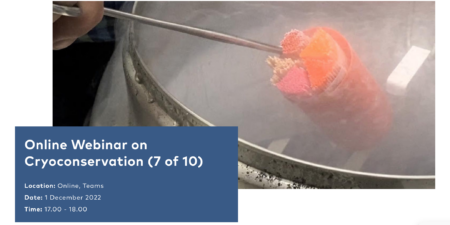It has somehow passed me by that FAO and NordGen have been running a series of webinars on “Innovations in cryoconservation of animal genetic resources,” in support of some new FAO guidelines. The next webinar on 1 December is the seventh in the series and will cover “Legal Issues: Acquisition, Storage and Transfer of Gene Bank Material.” Recordings of previous ones, and associated presentations, are on the FAO website.
Big Ag tells world how to fix ag, world tells Big Ag “heal thyself”
Readers may remember a recent Nibble on a report by some Big Ag head honchos saying that we’re destroying the planet and we should, you know, stop. That was met mainly by shouts of “who’s this we?” and variations thereof.
Well, so now there’s a another report by what seems to be a different set of Big Ag head honchos, but the response is predictably similar.
All grist to the COP27 mill, I guess, where for once agriculture is front and center.
You see what I did there?
Nibbles: Indian millets, Coconut breeding, Bhutan seed systems, Bangladesh gardens, Innovea coffee breeding network, Israel and NZ genebanks
- India decides to export millets. How about conserving them?
- India releases a new coconut. How about new millets?
- Bhutan BOLDly studies its seed systems. Maybe even including some millets.
- Bangladesh revives floating gardens. No millets.
- Coffee gets an international breeding network. Do millets have one?
- Israel‘s and New Zealand‘s genebanks make the news. How about millet genebanks?
Brainfood: Coconut in vitro, Clean cryo, Chickpea & lentil collections, Genebank data history, Eurisco update, Mining genebank data, TIK, Sampling strategy, Drones, GIS, Mexican CWR, Post-2020 biodiversity framework
- Thiamine improves in vitro propagation of sweetpotato [Ipomoea batatas (L.) Lam.] – confirmed with a wide range of genotypes. Getting there, keep tweaking…
- Minimizing the deleterious effects of endophytes in plant shoot tip cryopreservation. Something else to tweak.
- Ex Situ Conservation of Plant Genetic Resources: An Overview of Chickpea (Cicer arietinum L.) and Lentil (Lens culinaris Medik.) Worldwide Collections. Thankfully not much in vitro and cryo involved. The main tweak necessary is to share more characterization data with breeders.
- Data, Duplication, and Decentralisation: Gene Bank Management in the 1980s and 1990s. Ah, but do calls for more data also reflect attempts to cut costs and build political bridges? And would that be so bad?
- EURISCO update 2023: the European Search Catalogue for Plant Genetic Resources, a pillar for documentation of genebank material. Arguably, Eurisco tries to do all of the above, and pretty well.
- Bioinformatic Extraction of Functional Genetic Diversity from Heterogeneous Germplasm Collections for Crop Improvement. You need fancy maths to make sense of all that data. And use it.
- Research Status and Trends of Agrobiodiversity and Traditional Knowledge Based on Bibliometric Analysis (1992–Mid-2022). Not much traditional knowledge in those databases, though, eh? That would be one hell of a tweak.
- Species-tailored sampling guidelines remain an efficient method to conserve genetic diversity ex situ: A study on threatened oaks. Meanwhile, some people are still trying to figure out the best way to tweak sampling strategies to add diversity to genebanks. Spoiler alert: you need data on individual species.
- Collecting critically endangered cliff plants using a drone-based sampling manipulator. You also need drones.
- Application of Geographical Information System for PGR Management. One thing you can do with all that data is map stuff. So at least the drones know where to go.
- Incorporating evolutionary and threat processes into crop wild relatives conservation. The only thing that’s missing from this is traditional knowledge. And maybe drones.
- Conserving species’ evolutionary potential and history: opportunities under the new post-2020 global biodiversity framework. All these data will allow us to measure how well we’re doing. And whether we can ask for cryotanks, drones, and better databases.
Nibbles: Ancient oils, “AGRA”, Seed libraries, Tonka bean, MGIS, Wild Arachis
- Remember the book on ancient Mesopotamian cookery in the last Nibbles? Ok well here’s a website on Vegetable Oils And Animal Fats In Early Urban Societies Of Syro-Mesopotamia. Esoteric? Moi?
- To come back down to earth, you could always read this hot take on the AGRA rebranding.
- Couldn’t be more down to earth than community seedbanks, aka seed libraries.
- The seeds of Dipteryx odorata will make your head float.
- The latest news from the Musa Germplasm Information System may float your boat. It did mine. But I’m into esoterica, didn’t you know?
- Nothing esoteric about wild peanuts any more.
